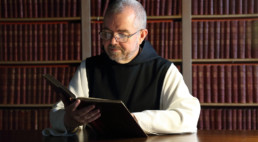The Study of Sacred Texts
God comes to us through nature, art, friendships, joy and suffering, but the deepest meaning of these experiences must be illuminated by the Word of God. Each day a Cistercian devotes time to reading and meditating upon the Word of God, a practice called Lectio Divina.
Four Movements
Traditionally, Lectio Divina has been described as progressing in four movements:
Lectio, reading the word of God.
Meditatio, meditating on that word.
Oratio, offering a prayer response to the meditated word.
Contemplatio, contemplation, that is, quietly abiding in the experience of being, heart and soul—a total “yes” to God.
Lectio Divina is a discipline whose fruits are experienced over time. One needs to understand the practice and then commit to it with some regularity.

A Gift from God
When we practice Lectio our intention is to open our hearts to the power of God’s Word. According to an old monastic teaching, when the monk reads, the Word of God passes through his mind and drops down and comes to rest on top of his heart. Then, the monk’s heart breaks open and the Word falls into it. God’s Word converts the heart and makes him a new creation. In Lectio, quite naturally and spontaneously, we find ourselves moved to the prayer of supplication, thanksgiving or adoration in response to God’s love communicated to us in the Sacred Scriptures.
Lectio Divina is a gift from God, one of the most precious He bestows on us. And so we pray: Thank you Father for the gift of your beloved Son, our Savior. Thank you for the sacred word he gave us. We believe this word has power to transform our lives and promise to dispose ourselves to receive this word.
Lectio Divina is a discipline whose fruits are experienced over time. One needs to understand the practice and then commit to it with some regularity.